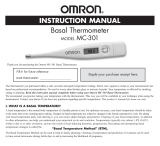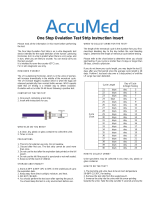Microlife MT 16C2 User manual
- Category
- Digital body thermometers
- Type
- User manual
This manual is also suitable for
Microlife MT 16C2 is a basal digital thermometer designed to help you track your menstrual cycle and ovulation. It accurately measures your basal temperature, which can help you identify your fertile days and plan for pregnancy or avoid it. The thermometer has a user-friendly design with a large display and a beep to indicate when the peak temperature is reached. It also features a memory function to store your previous readings, allowing you to track your temperature over time.
Microlife MT 16C2 is a basal digital thermometer designed to help you track your menstrual cycle and ovulation. It accurately measures your basal temperature, which can help you identify your fertile days and plan for pregnancy or avoid it. The thermometer has a user-friendly design with a large display and a beep to indicate when the peak temperature is reached. It also features a memory function to store your previous readings, allowing you to track your temperature over time.







-
 1
1
-
 2
2
-
 3
3
-
 4
4
-
 5
5
-
 6
6
-
 7
7
-
 8
8
Microlife MT 16C2 User manual
- Category
- Digital body thermometers
- Type
- User manual
- This manual is also suitable for
Microlife MT 16C2 is a basal digital thermometer designed to help you track your menstrual cycle and ovulation. It accurately measures your basal temperature, which can help you identify your fertile days and plan for pregnancy or avoid it. The thermometer has a user-friendly design with a large display and a beep to indicate when the peak temperature is reached. It also features a memory function to store your previous readings, allowing you to track your temperature over time.
Ask a question and I''ll find the answer in the document
Finding information in a document is now easier with AI
in other languages
- español: Microlife MT 16C2 Manual de usuario
Related papers
-
Microlife MT16I2 User manual
-
Microlife MT 1671 User manual
-
Microlife NC 100 User manual
-
Microlife NC200 Non Contact Thermometer User manual
-
Microlife NC 100 Owner's manual
-
Microlife IR200 Owner's manual
-
Microlife NC 200 User manual
-
Microlife NC 150 BT User manual
-
Microlife NC 150 Owner's manual
-
Microlife NC 120 User manual
Other documents
-
 Omron Healthcare MC-301 User manual
Omron Healthcare MC-301 User manual
-
Vicks OviTrack User manual
-
 OvaCue Mobile Fertility Monitor Owner's manual
OvaCue Mobile Fertility Monitor Owner's manual
-
laerdal LGH Sister-U User guide
-
Thermometers Basal Body Temperature User guide
-
 AccuMed 160401 Operating instructions
AccuMed 160401 Operating instructions
-
 Summer Infant 3140 User manual
Summer Infant 3140 User manual
-
Citizen CT915 User manual
-
laerdal LM MamaBirthie User guide
-
ADC Adtemp 423 Use And Maintenance











